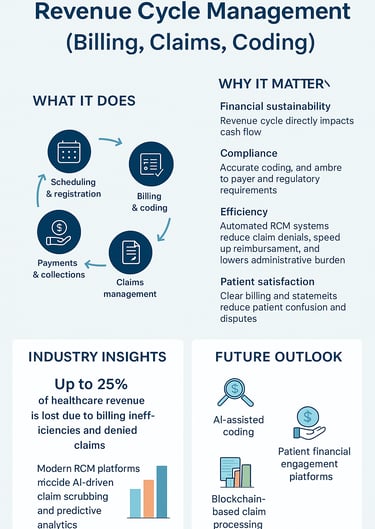Revenue Cycle Management in Healthcare: (Billing, Claims, Coding)
Discover how revenue cycle management (RCM) optimizes billing, claims, and coding in healthcare. Learn about the essential steps for capturing and managing patient service revenue effectively.
9/30/20251 min read


Revenue Cycle Management:
What It Does
Revenue Cycle Management (RCM) is the backbone of financial operations in healthcare. It encompasses every administrative and clinical function that contributes to capturing, managing, and collecting patient service revenue. This includes:
Scheduling & registration – capturing patient demographics and insurance details.
Billing & coding – applying accurate ICD-10, CPT, and HCPCS codes for diagnoses and procedures.
Claims management – submitting claims to payers, managing denials, and resubmitting corrections.
Payments & collections – posting remittances, reconciling balances, and issuing patient statements.
Why It Matters
Financial sustainability: RCM directly impacts a hospital’s or clinic’s cash flow.
Compliance: Accurate coding reduces audit risks and ensures adherence to payer and regulatory requirements.
Efficiency: Automated RCM systems reduce claim denials, speed up reimbursement, and lower administrative burden.
Patient satisfaction: Clear billing and transparent statements reduce patient confusion and disputes.
Industry Insights
According to the Healthcare Financial Management Association (HFMA, 2023), up to 25% of healthcare revenue is lost due to billing inefficiencies and denied claims.
Modern RCM platforms integrate AI-driven claim scrubbing and predictive analytics to flag coding errors before submission.
Vendors such as Epic Resolute, Cerner RevElate, and athenaCollector lead the market, while startups like Waystar and R1 RCM focus on automation and cloud-based services.
Future Outlook
Emerging trends include:
AI-assisted coding for more accurate claim generation.
Patient financial engagement platforms offering cost estimates before services.
Blockchain-based claim processing for transparency and fraud reduction.
